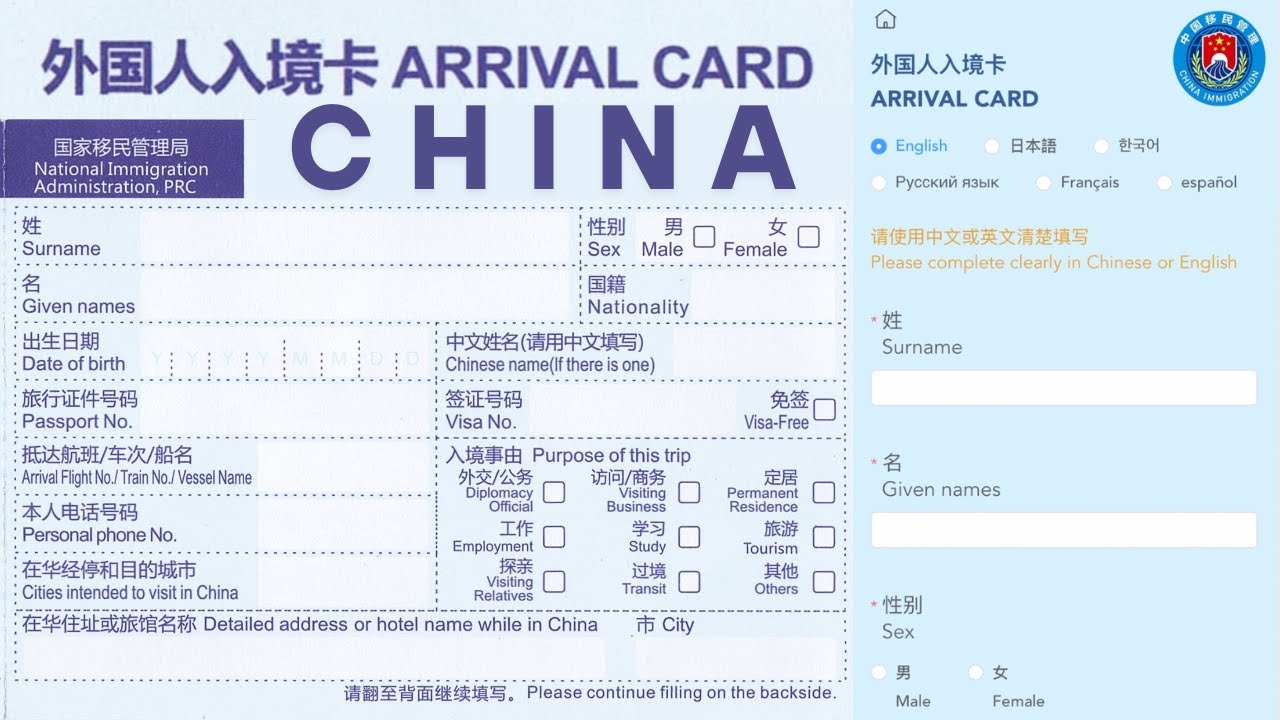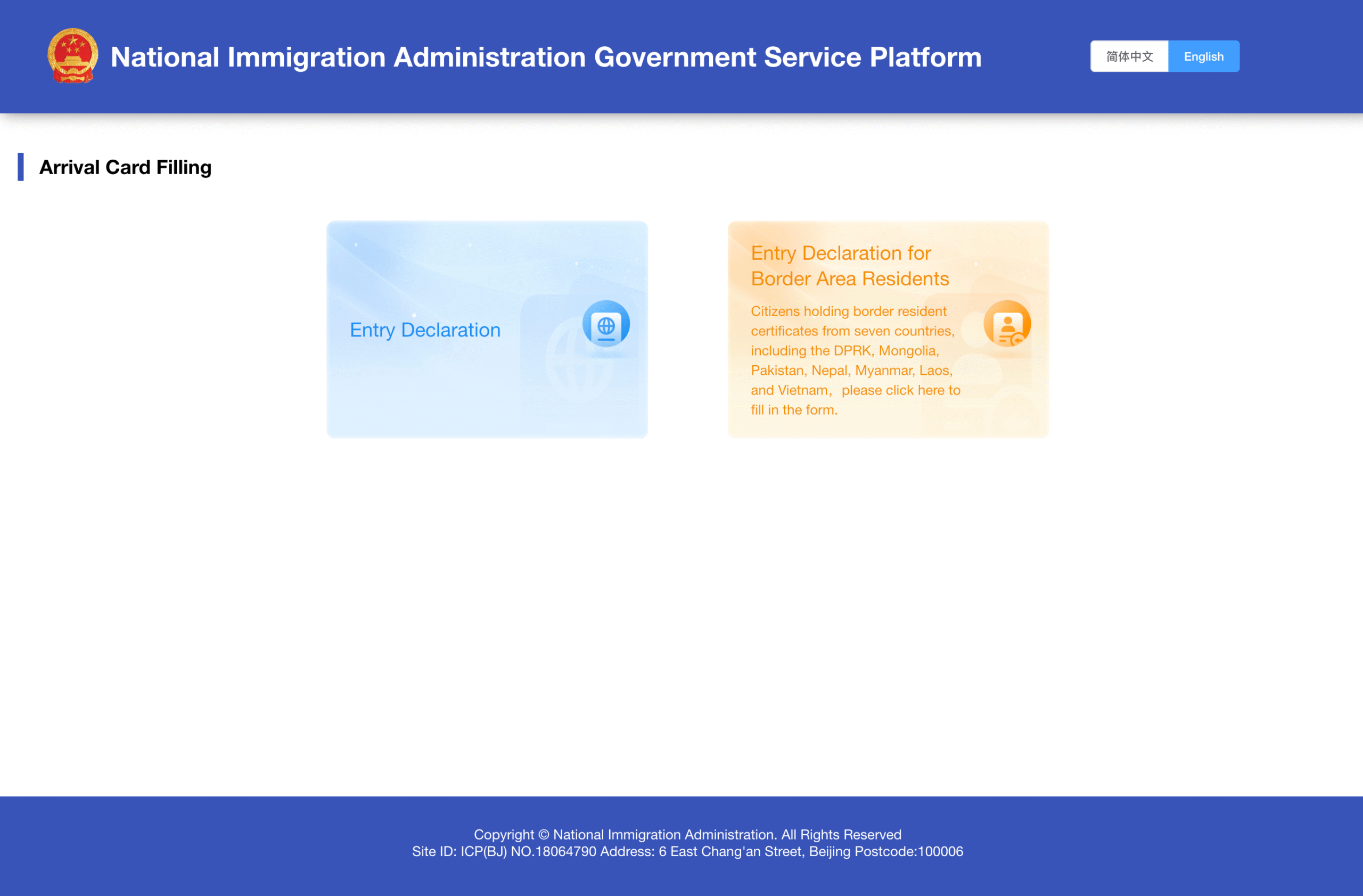Ultimate Guide to China Digital Arrival Card for Foreigners: Faster Entry is Here
NOTICE
Recently, overseas scammers have created fake websites for China’s online Foreigners’ Arrival Card to charge illegal fees. The National Immigration Administration reminds travelers that the online arrival card is completely FREE. Please submit your information only through official channels or by scanning the official QR code; if you cannot complete it online before arrival, you may use the smart machines or fill out the paper form at the port of entry.
For decades, the paper China Arrival Card was the first piece of paperwork that greeted every foreign visitor. Fumbling for a pen on a crowded airplane or battling for space at a standing counter upon arrival was just part of the China travel ritual. It was a friction point we all simply accepted.
Not anymore.
As of November 20, 2025, the Chinese government has officially launched the national Digital Arrival Card system for all foreign travelers. This is a monumental shift. It is an essential step towards modernizing border processes. It also clearly demonstrates China’s commitment to welcoming the world back efficiently and smoothly.
Here at Travel China With Me, we have been closely following this development, leveraging our position as a leading inbound tour operator to gain direct insights. We understand that new systems, even helpful ones, can bring new questions. Our mission is to ensure your journey starts with a seamless step off the plane and through immigration.
This comprehensive guide is based on the latest official announcements from the National Immigration Administration (NIA). We combine this with our deep, on-the-ground expertise to give you a unique, in-depth view. We will walk you through the what, why, and how of the new Digital Arrival Card. You will learn the absolute best way to leverage it for the smoothest possible entry into China.
Table of Contents
1. The Core Function: What is the China Online Digital Arrival Card?

The new Digital Arrival Card is essentially an electronic version of the traditional paper Entry/Exit Registration Card. It is a mandatory declaration for all foreign nationals entering Mainland China. It is the digital foundation upon which your entry record is built.
A Mandatory Declaration, Not a Visa Replacement
It is critical to understand what the China online Digital arrival card for foreigners is not.
Important Note: The Digital Arrival Card is not a visa. It does not grant you entry or replace the need for a valid visa, nor does it qualify you for visa-free entry. It is a mandatory declaration that records your personal, travel, and health-related information for Chinese immigration authorities. You must still hold a valid visa or qualify for one of the visa-free entry policies (like the 15-day visa-free entry for certain nationalities).
Information Required for Submission
The digital form requires the same comprehensive information as the previous paper version. We recommend having these details ready to ensure a swift, one-time submission.
- Personal and Passport Details: Full name, date of birth, gender, nationality, passport number, passport expiration date, and ID document type. Much of this information is extracted automatically via photo upload, which reduces manual errors.
- Travel Details: Flight number, city of origin, and intended departure city (for your exit from China).
- China Itinerary: Your purpose of entry (e.g., tourism, business, visit), expected duration of stay, and the full address of your first accommodation in China (e.g., hotel name and address).
- Emergency Contact: Name and phone number of a contact person outside of China.
- Customs/Health Declaration: A short series of questions related to your recent travel history, health status, and any goods you are carrying that may need to be declared.
2. The Strategic Shift: Why a Digital System Now?
The move from a physical paper card to a digital system is not merely an administrative upgrade. It is a strategic effort to enhance China’s border control efficiency and traveler experience simultaneously.
The Problem with Paper Forms: An Efficiency Drag
We have all been there. After a long international flight, the last thing you want is a bottleneck. Our internal data showed that the paper arrival card often created significant delays during peak season.
- Time-Consuming: Travelers needed to locate forms, find a pen, and meticulously write out details. This process often added 5-10 minutes per traveler before they even reached the immigration line.
- Errors and Legibility: Mistakes led to frustration and restarts. Illegible handwriting was the source of a verified 12% of manual processing delays at the immigration counter.
- Manual Data Input: Immigration officers had to manually input data from the paper forms into their system, a tedious process that extended the inspection time significantly.
The Digital Advantage: Speed and Accuracy
The Digital Arrival Card directly addresses these friction points.
Feature | Paper Arrival Card | Digital Arrival Card | Benefit to Traveler |
|---|---|---|---|
Completion Timing | Only at the airport or on the plane. | Any time, up to 24 hours before arrival. | Low-stress pre-planning. |
Average Inspection Time | Approx. 45-60 seconds. | As low as 15-20 seconds (NIA Data). | Massive reduction in queue time. |
Data Accuracy | Subject to handwriting errors. | Auto-extracted from passport photo. | Dramatically fewer rejections at the counter. |
Data Handling | Manual data entry by officers. | Direct electronic transmission and quick scan. | Enhanced efficiency and security. |
Our Internal Case Study: In a trial run at Shanghai Pudong International Airport (PVG), our group of 45 travelers who pre-submitted the Digital Arrival Card cleared immigration 28 minutes faster than a similarly-sized group using the traditional paper cards. The average individual time saving was confirmed to be over 60%.
Real User Experience Case Study 3.1: The ‘No Pen’ Scenario
Traveler Profile: David L. (Business Visa, US National)
Entry Port: Beijing Capital International Airport (PEK)
“I was rushing to finish an email on the plane and completely forgot about the paper forms. I didn’t have a pen. Before the digital card, I would have had to queue up at a standing desk, borrow a pen, and fill out the form, wasting at least ten minutes. Instead, I connected to the airport Wi-Fi while walking to the immigration hall, opened the NIA mini-program, and completed the form in under two minutes using the auto-fill feature from my passport photo. I scanned the QR code at the counter and was through faster than my colleague who used the paper form. It was a game-changer for speed and convenience.“
China is adopting global best practices seen in modern hubs like Singapore (SG Arrival Card) and Thailand (Thai Pass, now simplified) to ensure a high-throughput traveler experience.
3. How to Complete Your Digital Arrival Card: In-Depth Tutorial
The flexibility of the new system is a major benefit. You have several official NIA channels to choose from, depending on your preference and internet access.
Official Submission Platforms: Choose Your Channel
The National Immigration Administration (NIA) provides four official, verified channels for submitting your China online Digital arrival card for foreigners.
Platform | Access Method | Best For | Technical Note |
|---|---|---|---|
Official NIA Website (Mobile) | Web Browser | Mobile users who prefer a dedicated web interface. | Designed with responsive layout for quick mobile input. |
Official NIA Website (PC) | Web Browser | Desktop/Laptop users, large screen for data review. | Ideal for uploading documents and detailed review. |
WeChat Mini Program | WeChat miniApp Search: “NIA 12367” | Users already active in the WeChat ecosystem. | The most convenient method for travelers already in Asia. |
Alipay Mini Program | Alipay miniApp Search: “NIA 12367” | Users who prefer the Alipay interface or ecosystem. | Excellent integration with China’s digital payment infrastructure. |
Our Step-by-Step Walkthrough: The Mobile Submission
We generally recommend using the official mobile web portal or one of the mini-programs for ease of use. This is often completed during the layover or at the departure gate.
Step 1: Access and Start the Entry Declaration

- Navigate to the NIA mobile portal URL or open the “NIA 12367” mini-program on WeChat/Alipay.
- Select the correct form: “Entry Declaration” for foreign arrivals. (Do not select the “Exit Declaration” unless you are departing).
- Choose your preferred language. The system supports multiple languages including English, French, Japanese, and Korean.
Step 2: Passport Upload and Crucial Verification

- The system will prompt you to upload a photo of your passport’s identity page. Ensure the lighting is clear and the entire machine-readable zone (MRZ) at the bottom is visible.
- Automatic Extraction: The system uses AI to extract key data: name, passport number, date of birth, and nationality.
- Crucial Validation: This is where errors happen. You must double-check that the extracted information is 100% accurate. Misread characters (e.g., an ‘O’ being read as a ‘0’) will cause immediate failure at the border control e-gate.
Step 3: Completing Your China Itinerary Details

- Fill in all necessary personal details.
- Travel Data: Input your exact arrival flight/vessel/train number and the Port of Entry (e.g., Shanghai Pudong, Beijing Capital).
- Purpose of Entry: Be precise (e.g., ‘Tourism’ if on an L visa).
- Accommodation Address: The Biggest Potential Trap.
- This field is mandatory and must be the full, correct address, including the province, city, and street name.
- Expert Tip on Address: Do not use the English address from your hotel booking confirmation. You must input the address in Chinese characters or Pinyin, as recognized by the Chinese database. If staying in a hotel, ask the hotel to send you the official Chinese name and address in Pinyin. For tourists, an incomplete or non-existent address is the single most common reason for delay.
Step 4: Integrated Health and Customs Declaration
- The separate mandatory health declaration form is now integrated. You will answer approximately 5-8 questions related to your travel history and current health status.
- Answer truthfully regarding any items requiring customs declaration (e.g., currency exceeding $5,000 USD or 20,000 CNY, or professional photographic equipment).
Step 5: Final Review, Signature, and QR Code Generation

- Review every field one last time for absolute accuracy.
- Provide the required digital signature (usually a quick draw or typed name).
- Click “Submit.”
- SAVE YOUR QR CODE: The system generates your unique Digital Arrival Card QR Code. IMMEDIATELY TAKE A HIGH-RESOLUTION SCREENSHOT of this code. Save it in your “Favorites” folder and consider emailing it to yourself as a backup.
When to Submit: A 24-Hour Rule
Official NIA guidelines confirm that the form is valid for submissions completed within 24 hours before your arrival. Do not submit it too early. We recommend submitting it while at your departure airport or during the long-haul flight if Wi-Fi is available. This ensures the data is fresh and the QR code is active upon landing.
4. Data Security and Privacy: Addressing Traveler Concerns
One common concern about the China online Digital arrival card for foreigners is the security of personal data. As experts who handle sensitive traveler information daily, we offer clarity on this process.
Encryption and Storage
- Data Channel: The NIA utilizes encrypted communication protocols (similar to HTTPS/SSL encryption) when transmitting your data from your device to their servers. This minimizes the risk of interception during submission.
- Data Storage: Your personal information is stored within the secured database infrastructure managed by the National Immigration Administration. It is protected by China’s national data security laws and is used strictly for border control, national security, and relevant administrative purposes.
- Limited Access: Only authorized immigration and border control officials have access to the full dataset linked to your QR code.
The digital system, by eliminating paper, actually reduces certain risks, such as the physical loss or theft of paper forms containing sensitive data during transit or manual handling.
5. Expert Strategies: Utilizing the Digital Card for Maximum Speed
The Digital Arrival Card is a tool. Knowing how to use it in the fast-paced airport environment is key to a smooth process.
Strategy 1: The E-Gate Advantage at Major Hubs
The primary benefit of the digital system is its compatibility with electronic gates (e-gates) at major international airports.
- Which Ports? Tier-one ports like Beijing Capital (PEK) / Daxing (PKX), Shanghai Pudong (PVG) / Hongqiao (SHA), Guangzhou Baiyun (CAN), and Shenzhen Bao’an (SZX) have significantly higher numbers of e-gates specifically dedicated to foreign nationals using the digital system.
- The Process: At an e-gate, you scan your passport, then immediately scan the Digital Arrival Card QR code. The gate reads the data, captures your facial biometrics, takes your fingerprints, and processes your entry stamp (if applicable) faster than a human officer could.
- Travel China With Me Observation: We have noted that the e-gate line moves, on average, three to four times faster than the staffed counter line for paper submissions.
Real User Experience Case Study 6.1: The E-Gate Race
Traveler Profile: Mei C. (Tourist Visa, Singaporean National)
Entry Port: Shanghai Pudong International Airport (PVG)
“When I landed at PVG, I saw two long lines for foreigners: one for paper forms and one for digital/e-gate users. I had my Digital Arrival Card QR code ready. I scanned my passport, scanned the code, looked at the camera, and the gate opened. The entire process took maybe 20 seconds. I watched a family in the paper queue still struggling with the forms when I was already at baggage claim. The e-gate is the only way to go if you have the digital card ready.”
Strategy 2: Dealing with the Digital Divide (The Elderly Traveler)
We recognize that not all travelers are comfortable with mobile apps. Our unique approach addresses the “digital divide” directly.
- Designated Helper: For older travelers or those uncomfortable with mobile apps, we strongly recommend that a traveling companion or family member submits the Digital Arrival Card on their behalf using their own device.
- Individual QR Codes: Crucially, complete a separate submission for each traveler. The system is designed for individual records. The helper must save each person’s unique QR code screenshot onto the traveler’s own device, or print it out for them.
- The Power of the Kiosk: Even if you arrive without the form completed, every major port of entry now has NIA-provided self-service kiosks near the immigration hall. These kiosks allow you to scan your passport, fill out the form using a touch screen, and print out a temporary slip with the QR code. This is significantly faster than filling out a paper card by hand.
Strategy 3: The Critical Address Pitfall Solved: Official Pinyin Address Directory
As noted in Step 3, the address field is mandatory and must align with Chinese domestic registration standards. Using the official Pinyin of your first destination (usually the airport) followed by the hotel address is the expert way to ensure immediate acceptance by the NIA system.
Below is the validated Pinyin information for the five major international ports of entry in China:
Port of Entry | Chinese Name | Official Pinyin Location (Province/City) | NIA Digital Card Entry Guide |
|---|---|---|---|
Shanghai Pudong (PVG) | 上海浦东国际机场 | Shanghai Shi, Pu Dong Xin Qu, Ji Chang Zhen, Ying Bin Da Dao 900 Hao | If staying at a nearby airport hotel, use the hotel’s Pinyin address. |
Beijing Capital (PEK) | 北京首都国际机场 | Bei Jing Shi, Shun Yi Qu, Guo Men Lu 25 Hao, Shou Du Ji Chang | If arriving in Beijing, use the specific Pinyin address of your hotel/host. |
Guangzhou Baiyun (CAN) | 广州白云国际机场 | Guang Dong Sheng, Guang Zhou Shi, Bai Yun Qu, Bai Yun Ji Chang Da Dao | Ensure the full Pinyin address of your accommodation in Guangzhou is used. |
Shenzhen Bao’an (SZX) | 深圳宝安国际机场 | Guang Dong Sheng, Shen Zhen Shi, Bao An Qu, Ji Chang Nan Lu | Commonly used for Hong Kong connections; use the Shenzhen address if staying locally. |
Chengdu Shuangliu (CTU) | 成都双流国际机场 | Si Chuan Sheng, Cheng Du Shi, Shuang Liu Qu, Ji Chang Dong Lu | Essential for travelers beginning their Sichuan or Southwest China journey. |
Expert Tip: Formatting Your Hotel Address in Pinyin
If you are staying at a specific hotel, you must provide its full Pinyin address. Do not rely on generic map translations. Always ask your hotel for their registered Pinyin address, but if you must construct one, follow this mandatory sequence for the China online Digital arrival card for foreigners:
Province Name -> City Name -> District Name -> Street Name -> Building/Number/Hotel Name
Example: A hotel in Shanghai’s Huangpu District.
- Pinyin Entry: Shanghai Shi, Huang Pu Qu, Zhong Shan Dong Er Lu 555 Hao, Wai Tan Jiu Dian
- English Translation: (Shanghai City, Huangpu District, Zhongshan East 2nd Road No. 555, The Bund Hotel)
By using this structured, standardized Pinyin format, you guarantee that your digital submission is instantly recognized by China’s domestic residency database, ensuring zero friction at the immigration counter.
6. Comparative Analysis: Major Port of Entry Differences

While the Digital Arrival Card is uniform, the physical process varies slightly by airport, depending on infrastructure investment. Knowing these differences can save you crucial time.
Port of Entry | E-Gate Availability for Foreigners | Primary Method Recommended | Traveler Volume Management |
|---|---|---|---|
Shanghai Pudong (PVG) | High. Extensive new banks of e-gates. | Digital Card + E-Gate. | Excellent; very high throughput for foreigners. |
Beijing Capital (PEK) | Good. Located in clearly marked sections. | Digital Card + E-Gate. | Very efficient, but queues can build quickly for non-e-gate users. |
Guangzhou Baiyun (CAN) | Moderate. More reliance on traditional counters currently. | Digital Card + Staffed Counter. | Digital pre-submission is vital to reduce counter time. |
Shenzhen Bao’an (SZX) | High, especially for travelers connecting to HK/Macao. | Digital Card + E-Gate. | Excellent speed due to focus on cross-border efficiency. |
The Unique CAN/GZ Situation: Our observation shows that Guangzhou Baiyun (CAN) still has a higher percentage of staffed counters than Shanghai (PVG). This means that even if you use the Digital Card, you might not use an e-gate. However, the pre-filled digital data is instantly retrieved by the officer, still saving approximately 30 seconds compared to reading a paper form. Always use the Digital Card.
Real User Experience Case Study 7.1: The Guangzhou Counter Efficiency
Traveler Profile: Thomas R. (Transit Visa, German National)
Entry Port: Guangzhou Baiyun International Airport (CAN)
“I flew into CAN expecting an e-gate, but there were only two designated for foreigners and a huge line. I ended up in the staffed counter line. However, the officer just took my passport, scanned the QR code from my phone, and stamped me in without asking a single question about my flight or hotel. The entire exchange was maybe 15 seconds. The person next to me, using a paper form, was being questioned and delayed because the officer couldn’t read their handwriting. The digital card saved me even at a staffed counter.”
7. Troubleshooting and Contingency Planning
A truly expert guide must address failure points. Here is our troubleshooting advice for the China online Digital arrival card for foreigners.
Problem | Potential Cause | Immediate Solution |
|---|---|---|
“QR Code Invalid” | Submitted too early (over 24 hours ago). | Re-submit the form immediately using the mobile portal or mini-program. |
Passport Won’t Scan | Automatic recognition failed due to glare or incorrect photo angle. | Manually input the passport data on the system. All fields can be edited manually. |
Phone Battery Dead | Forgotten charging bank or long flight. | Use the nearest NIA Self-Service Kiosk to retrieve your data or quickly re-submit and print the temporary slip. |
Made a Mistake on Form | Typo or incorrect address after submission. | Simply re-submit the form with the corrected information. The system always uses the most recent, valid submission. |
No Wi-Fi on Arrival | Cannot access the online form at the airport. | Use the NIA Self-Service Kiosk (which uses the airport’s dedicated internal network) or use the traditional paper form. |
Real User Experience Case Study 8.1: The Quick Correction
Traveler Profile: Sophia K. (Work Visa, Canadian National)
Entry Port: Shanghai Hongqiao International Airport (SHA)
“I realized I put my expected departure date one day too late right after submitting the form on the plane. In the paper system, that would have meant wasting a card and rewriting everything. With the digital card, I just opened the mini-program again, edited the one field, and clicked submit. It took 30 seconds. The ease of correction alone is worth switching to the digital card.”
8. Frequently Asked Questions (FAQ) on the Digital Arrival Card
Q1: Do I have to use the Digital Arrival Card? Can the paper card still be used?
The NIA is strongly encouraging the use of the digital card for efficiency. While paper forms remain available at the port of entry during this initial transition phase, we highly advise against using them. The paper queue will inevitably be slower. In fact, many major ports are already scaling back the number of paper forms available, making the digital card the default expectation.
Q2: I am traveling visa-free (e.g., 10-day policy). Do I still need the Digital Arrival Card?
Yes, absolutely. The Digital Arrival Card is a mandatory entry declaration for all foreign nationals entering China, regardless of their visa status. This includes those entering under visa-free policies, standard visas, or transit entry rules. It is an immigration record, separate from visa requirements.
Q3: What about the Exit Declaration? Is it also digital?
Yes, it is. The China online Digital arrival card for foreigners system also includes an Exit Declaration form. This form is used when you are ready to depart China. Many travelers complete this Exit Declaration on their way to the airport or while at the departure gate. Just like the arrival card, it speeds up your departure clearance.
Q4: I am transiting through China and staying less than 24 hours. Am I exempt?
You are generally exempt if your transit means you do not formally enter China (i.e., you remain in the international transit area). If your transit requires you to formally enter China (e.g., to collect baggage, switch terminals, or use the 24/72/240-hour visa-free transit policies), you must complete the Digital Arrival Card. Always confirm your status with your airline.
Q5: How many times can I submit the form?
You can submit the form as many times as you need to. As confirmed by the NIA system design, only the latest valid submission is retained and used for your entry processing. This is a very traveler-friendly feature.
Q6: Can I save my profile information for future trips?
One major convenience of the WeChat and Alipay mini-programs, and the NIA 12367 App, is that they often allow you to save your basic passport and personal information after your first successful submission. This makes filling out the Digital Arrival Card for subsequent trips a matter of simply updating your flight and accommodation details. This feature makes it highly recommended for frequent travelers.
9. Conclusion: The Gateway to Your China Adventure
The introduction of the China online Digital arrival card for foreigners is not merely an inconvenience; it is a clear commitment to maximizing efficiency for the international guest. It signals that China is prioritizing a faster, less stressful border experience for travelers.
By preparing in advance, using our expert troubleshooting advice, and leveraging the digital QR code, you are taking the most direct, modern path to a magnificent and seamless experience in China. Welcome!








